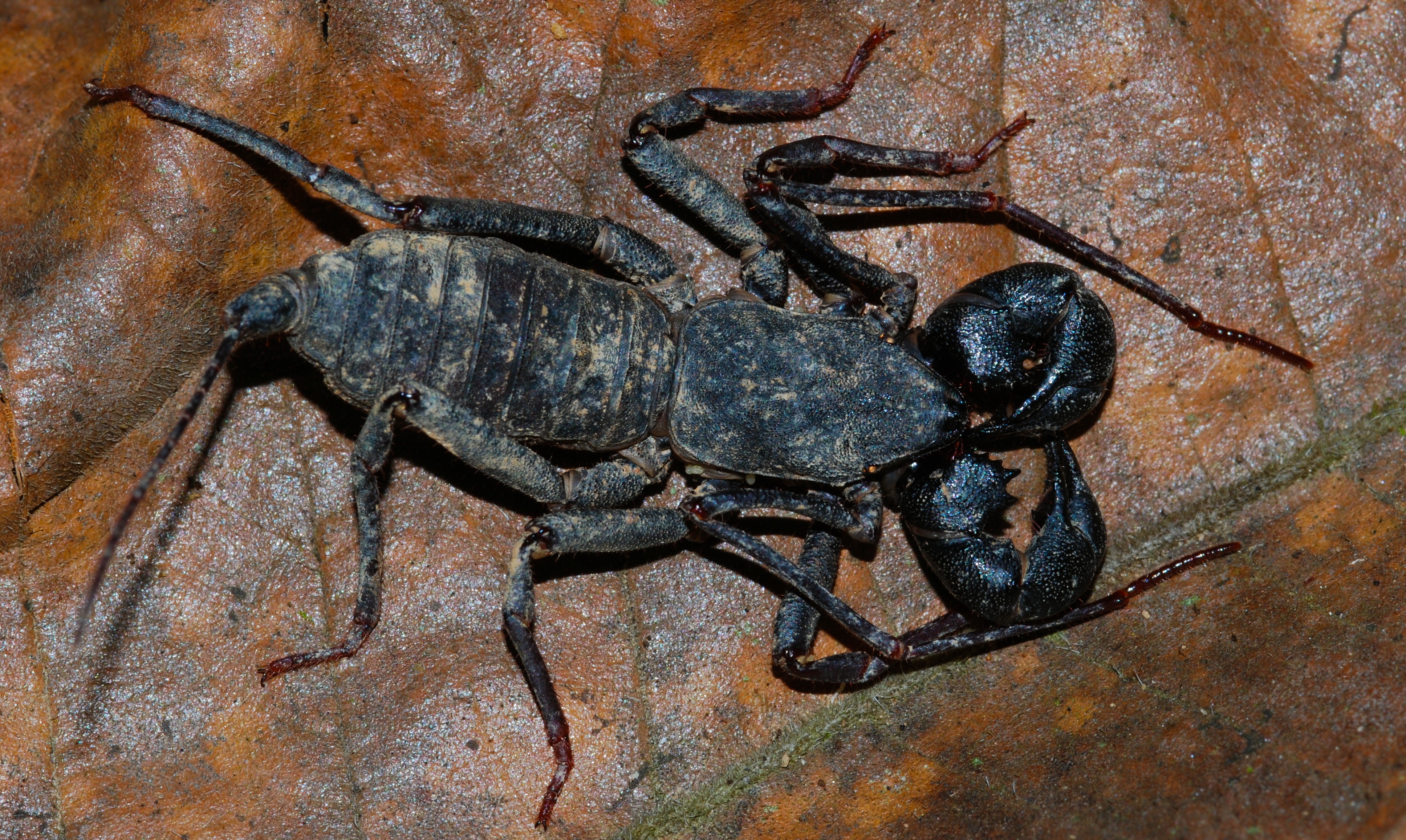Thelyphonidae on:
[Wikipedia]
[Google]
[Amazon]
Thelyphonidae is the sole family in the
The first whipspider (Arachnida: Amblypygi) and three new whipscorpions (Arachnida: Thelyphonida) from the Lower Cretaceous Crato Formation of Brazil
Transactions of the Royal Society of Edinburgh: Earth Sciences, 92, 325-334, 2002.
 *'' Mastigoproctus'' Pocock, 1894
*'' Mayacentrum'' Viquez & de Armas, 2006
*'' Mimoscorpius'' Pocock, 1894
*'' Sheylayongium'' Teruel, 2018
*''
*'' Mastigoproctus'' Pocock, 1894
*'' Mayacentrum'' Viquez & de Armas, 2006
*'' Mimoscorpius'' Pocock, 1894
*'' Sheylayongium'' Teruel, 2018
*''
 *'' Abaliella'' Strand, 1928
*'' Chajnus'' Speijer, 1936
*'' Ginosigma'' Speijer, 1936
*'' Glyptogluteus'' Rowland, 1973
*'' Minbosius'' Speijer, 1936
*'' Tetrabalius'' Thorell, 1888
*'' Thelyphonoides'' -
*'' Abaliella'' Strand, 1928
*'' Chajnus'' Speijer, 1936
*'' Ginosigma'' Speijer, 1936
*'' Glyptogluteus'' Rowland, 1973
*'' Minbosius'' Speijer, 1936
*'' Tetrabalius'' Thorell, 1888
*'' Thelyphonoides'' -
 *'' Typopeltis'' Pocock, 1894
*'' Typopeltis'' Pocock, 1894
Thelyphonida
Thelyphonida is an arachnid order comprising invertebrates commonly known as whip scorpions or vinegaroons (also spelled vinegarroons and vinegarones). They are often called uropygids in the scientific community based on an alternative name for ...
order of arachnid
Arachnida () is a class of joint-legged invertebrate animals (arthropods), in the subphylum Chelicerata. Arachnida includes, among others, spiders, scorpions, ticks, mites, pseudoscorpions, harvestmen, camel spiders, whip spiders and vinegar ...
s.
Description
Thesearachnid
Arachnida () is a class of joint-legged invertebrate animals (arthropods), in the subphylum Chelicerata. Arachnida includes, among others, spiders, scorpions, ticks, mites, pseudoscorpions, harvestmen, camel spiders, whip spiders and vinegar ...
s can reach a length of . The body consists of a cephalothorax coated with chitin and of an abdomen divided into 12 segments.
Fossil record
The largest of prehistoric whipscorpions and possibly the largest-known whipscorpion ever discovered was '' Mesoproctus'' from this family. While ''M. rowlandi'' reached in length (without tail), an unnamed species ''M. sp.'' had a carapace of in length and in width, comparable or even larger than the extant '' Mastigoproctus'' have.Jason A. Dunlop, David M. MartillThe first whipspider (Arachnida: Amblypygi) and three new whipscorpions (Arachnida: Thelyphonida) from the Lower Cretaceous Crato Formation of Brazil
Transactions of the Royal Society of Edinburgh: Earth Sciences, 92, 325-334, 2002.
Genera
Most genera are currently placed in four recognised subfamilies:Hypoctoninae
Auth.: Pocock, 1899 *'' Etienneus'' Heurtault, 1984 *'' Hypoctonus'' Thorell, 1888 *'' Labochirus'' Pocock, 1894 *'' Thelyphonellus'' Pocock, 1894 *'' Ravilops'' Viquez & de Armas, 2005Mastigoproctinae
Auth.: Speijer, 1933 *'' Mastigoproctus'' Pocock, 1894
*'' Mayacentrum'' Viquez & de Armas, 2006
*'' Mimoscorpius'' Pocock, 1894
*'' Sheylayongium'' Teruel, 2018
*''
*'' Mastigoproctus'' Pocock, 1894
*'' Mayacentrum'' Viquez & de Armas, 2006
*'' Mimoscorpius'' Pocock, 1894
*'' Sheylayongium'' Teruel, 2018
*''Uroproctus
''Uroproctus'' is a monotypic genus of Thelyphonid whip scorpions, first described by Reginald Innes Pocock in 1894. Its single species, ''Uroproctus'' ''assamensis'' is distributed in Bangladesh, Bhutan, Cambodia, India and Nepal
Nepa ...
'' Pocock, 1894
*'' Valeriophonus'' Viquez & de Armas, 2005
Thelyphoninae
Auth.: Lucas, 1835 *'' Abaliella'' Strand, 1928
*'' Chajnus'' Speijer, 1936
*'' Ginosigma'' Speijer, 1936
*'' Glyptogluteus'' Rowland, 1973
*'' Minbosius'' Speijer, 1936
*'' Tetrabalius'' Thorell, 1888
*'' Thelyphonoides'' -
*'' Abaliella'' Strand, 1928
*'' Chajnus'' Speijer, 1936
*'' Ginosigma'' Speijer, 1936
*'' Glyptogluteus'' Rowland, 1973
*'' Minbosius'' Speijer, 1936
*'' Tetrabalius'' Thorell, 1888
*'' Thelyphonoides'' - monotypic
In biology, a monotypic taxon is a taxonomic group (taxon) that contains only one immediately subordinate taxon. A monotypic species is one that does not include subspecies or smaller, infraspecific taxa. In the case of genera, the term "unispe ...
'' Thelyphonoides panayensis'' Krehenwinkel, Curio, Tacud & Haupt, 2009
*'' Thelyphonus'' Latreille, 1802
*†'' Mesothelyphonus'' Cai and Huang, 2017 (Burmese amber
Burmese amber, also known as Burmite or Kachin amber, is amber from the Hukawng Valley in northern Myanmar. The amber is dated to around 100 million years ago, during the latest Albian to earliest Cenomanian ages of the mid-Cretaceous period. The ...
, Cenomanian)
Typopeltinae
Auth.: Rowland & Cooke, 1973 *'' Typopeltis'' Pocock, 1894
*'' Typopeltis'' Pocock, 1894
''
Incertae sedis
' () or ''problematica'' is a term used for a taxonomic group where its broader relationships are unknown or undefined. Alternatively, such groups are frequently referred to as "enigmatic taxa". In the system of open nomenclature, uncertain ...
''
*''† Mesoproctus'' Dunlop, 1998 (Crato Formation
The Crato Formation is a geologic formation of Early Cretaceous (Aptian) age in northeastern Brazil's Araripe Basin. It is an important Lagerstätte (undisturbed fossil accumulation) for palaeontologists. The strata were laid down mostly during ...
, Aptian)
References
External links
* {{Taxonbar, from=Q3523569 Arachnid families Thelyphonida